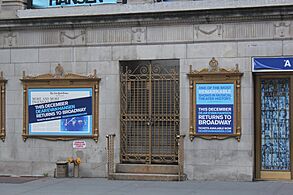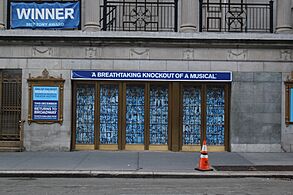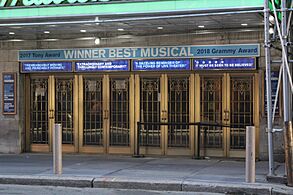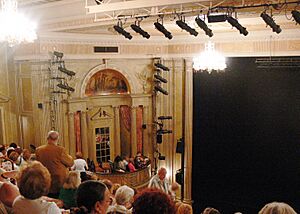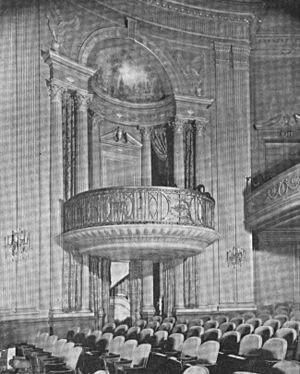Music Box Theatre facts for kids
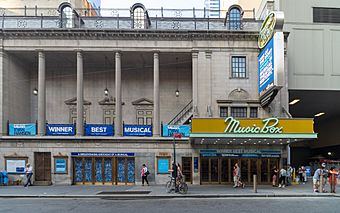
Showing the musical Dear Evan Hansen in 2019
|
|
| Address | 239 West 45th Street Manhattan, New York United States |
|---|---|
| Coordinates | 40°45′32″N 73°59′14″W / 40.758864°N 73.987178°W |
| Owner | Shubert Organization |
| Type | Broadway |
| Capacity | 1,025 |
| Construction | |
| Opened | September 22, 1921 |
| Years active | 1921–present |
| Architect | C. Howard Crane |
| Designated | December 8, 1987 |
| Reference no. | 1359 |
| Designated entity | Facade |
| Designated | December 8, 1987 |
| Reference no. | 1360 |
| Designated entity | Auditorium interior |
The Music Box Theatre is a famous Broadway theater in New York City. It is located at 239 West 45th Street in the busy Theater District of Midtown Manhattan. The theater first opened its doors in 1921.
It was designed by C. Howard Crane with a special style inspired by Palladian architecture. The theater was built for two important people: songwriter Irving Berlin and producer Sam H. Harris. The Music Box Theatre has 1,025 seats spread across two levels. Today, it is managed by The Shubert Organization. Both the outside (called the facade) and the inside (the auditorium) are protected as New York City landmarks.
The outside of the theater is made of limestone and looks very balanced. It has a mix of Palladian and neo-Georgian styles. The main entrance is on the eastern side, with a large sign called a marquee above it. The stage door is on the western side. Inside, the theater has beautiful decorations in the Adam style. It features a large balcony and two special curved box seats. The theater also has a small lobby, a comfy lounge in the basement, and offices on the mezzanine level.
Sam H. Harris first thought of building the Music Box Theatre in 1919. He wanted a special place for his shows with Irving Berlin. The Shubert family became part owners soon after the theater opened. For many years, the Music Box mainly showed the Music Box Revue shows. Its first play, Cradle Snatchers, opened in 1925. Many early shows at the Music Box were very popular, running for hundreds of performances. Famous writers like Moss Hart and George S. Kaufman had many plays here in the 1930s. These included Once in a Lifetime and The Man Who Came to Dinner.
After Sam Harris passed away in 1941, Irving Berlin and the Shuberts shared ownership. The Music Box then mostly showed dramas instead of musicals. In the 1950s, several plays by William Inge were performed here. Even though shows didn't run as long in later years, the Music Box has been used for theater ever since it opened. The Shuberts bought Berlin's share of the theater in 2007.
Contents
Theater Location and Surroundings
The Music Box Theatre is located at 239 West 45th Street. It sits on the north side of the street, between Eighth Avenue and Broadway. This area is very close to Times Square in the Theater District of Midtown Manhattan, New York City. The land the theater is on covers about 10,050 square feet. The theater's front along 45th Street is about 100 feet wide and it goes back about 100 feet deep.
The part of 45th Street where the theater is located is also known as George Abbott Way. Many people walking on this street help theaters sell more tickets. The Music Box is on the same block as the Richard Rodgers Theatre and Imperial Theatre. The New York Marriott Marquis hotel is also nearby. Other theaters close by include the Gerald Schoenfeld, Booth, Shubert, and Broadhurst Theatres.
Theater Design and Features
The Music Box Theatre was designed by C. Howard Crane. It was built between 1920 and 1921 for Irving Berlin and Sam H. Harris. The inside was decorated by Crane and William Baumgarten. They added many details in the Adam style. The Longacre Engineering and Construction Company built the theater. Today, The Shubert Organization runs the Music Box.
Outside Look: The Facade
The outside of the theater, called the facade, is made of limestone. It looks very balanced, even though the theater is wider than it is deep. Crane used ideas from both Palladian and neo-Georgian styles for the design. The biggest part of the facade is a tall central colonnade with columns. This colonnade covers the second and third floors.
On the eastern side of 45th Street, there are four sets of glass and bronze doors. These lead to the ticket lobby. A large marquee hangs above the entrance. The middle of the ground floor has three sets of glass and bronze doors that lead from the auditorium. On the western side, there are double doors and a single door. These are the stage doors, where actors and crew enter. Above the ground floor, there's a decorative band with designs of swags and urns.
On the second and third floors, there is a colonnade with four fluted columns. These columns have fancy Corinthian-style tops. Behind the columns, there's a slightly set-back area with iron railings. This area is where the auditorium's fire escape is located. There are also three double doorways that open onto this area. The top of the facade has a decorative band with rosette designs. Above that is a sloping slate roof with windows.
Inside Look: The Auditorium
The auditorium is the main seating area inside the theater. It has a lower level called the orchestra, one balcony, special boxes, and a stage. The auditorium is wider than it is deep. It is decorated with plaster designs that stand out. The Shubert Organization says the theater has 1,025 seats. The orchestra level has 538 seats, the balcony has 455 seats, and the boxes have 16 seats. The front of the orchestra also has 35 seats in the orchestra pit.
Seating Areas
At the back of the orchestra level, there is a shallow walkway. The orchestra seating area slopes down towards the stage. The back wall of this walkway has doorways with Corinthian-style pillars. A staircase leads up to the balcony's lobby and another leads down to a basement lounge. Both stairs have railings in the Adam style. The walls of the orchestra area have decorative plaster panels.
The balcony level also slopes down. Its walls have plaster panels. The front of the balcony curves outwards and has designs of vines, flowers, and medallions. Modern light boxes are in front of the balcony. A technical booth is at the back. The underside of the balcony is divided into panels with plaster medallions and lights.
On each side of the stage, there is an archway with a single box seat at the balcony level. These boxes are curved and stick out from the wall. They are reached by stairs from the orchestra level. The archways for the boxes are supported by six Corinthian columns. Inside each archway, there are mirrored panels. The front of the boxes has metal railings with Adam-style designs. Above the box seats, there is a half-dome with a painting of old ruins.
Other Design Features
Next to the boxes is the flat archway around the stage, called the proscenium arch. This archway is decorated with fluted columns and pillars in the Corinthian style. The top of the archway has Adam-style decorations like urns and vines. The proscenium is about 26 feet high and 40 feet wide. Because there isn't much space backstage, a special system was put in place to lift sets and other items onto the stage. The ceiling has Adam-style moldings and designs that divide it into sections. It also has air-conditioning vents.
Other Inside Spaces
The Music Box's lobby is connected to the back walkway of the orchestra. The lobby is about 8 feet wide and 25 feet long. It was designed to be simple, with pink marble on the lower walls and marble walls. A bronze box-office booth was placed in the lobby. The floor was made of alternating gray and pink marble tiles. Curtains separated the lobby from the auditorium to stop drafts.
On the balcony level, there is a mezzanine. This level used to have Irving Berlin's studio. It also had ladies' rooms, telephone rooms, and offices for managers. Berlin's studio looked like an attic, with exposed ceiling beams and a stone fireplace.
Below the auditorium, there is a basement lounge. This lounge was designed to be very fancy, unlike lounges in many other Broadway theaters. Architecture and Building magazine said it looked more like a room in a house than a public place. The staircase leading to the basement lounge is made of marble. A tapestry showing a reclining woman by a waterfall hangs on the stair landing. The lounge also has mirrored panels and marble fireplaces. The theater's restrooms are also in the basement.
History of the Music Box Theatre
The area around Times Square became the main place for big theater shows between 1900 and the Great Depression. During the early 1900s, many theaters in Midtown Manhattan were built by the Shubert brothers. They were a major group in the theater world. Meanwhile, Sam H. Harris was a producer, and Irving Berlin was a famous songwriter. Before the Music Box Theatre, Harris had worked with George Cohan on several theaters and shows.
Building the Theater and Early Shows
A Home for Revues
The name "Music Box Theatre" came from a conversation between Sam H. Harris and Irving Berlin in 1919. Harris suggested building a theater, and Berlin thought of the name "Music Box." Harris liked it and suggested Berlin write a song for the new theater. In March 1920, Harris and Berlin bought the land for the theater. By May, Crane had finished the plans. Harris wanted to put on two big shows a year. The Music Box Theatre ended up costing over $1 million to build. It was one of the few Broadway theaters built specifically for certain producers' shows.
The Music Box Theatre opened on September 22, 1921, with performances of the Music Box Revue. Both architecture and theater critics praised the new theater. Many magazines printed pictures of it. The New-York Tribune said the outside of the theater looked great and showed what was inside. Variety (magazine)|Variety magazine called the Music Box the "daintiest theatre in America." The comedian Sam Bernard simply said, "It stinks from class," meaning it was very classy. Producer Moss Hart wrote in his book that the Music Box was "everybody's dream of a theatre."
Film executive Joseph M. Schenck was originally a partner in the Music Box Theatre. But he soon gave his share to the Shubert brothers. For its first three years, the Music Box only showed the Music Box Revue. The first show in 1921 starred Bernard and Berlin. Three more versions of the Music Box Revue were shown in the following years. Famous performers like the Brox Sisters and Fanny Brice appeared in these shows. Earl Carroll's Vanities was also staged in 1924.
Popular Shows of the 1920s and 1930s
The comedy The Cradle Snatchers, starring Humphrey Bogart, was the first play at the Music Box. It opened in 1925 and was a big hit, running for almost 500 performances. Most shows at the Music Box in its first ten years were successful. The comedy Chicago premiered in late 1926. The play Paris Bound opened in 1927, followed by Paris in 1928. The 1920s ended with The Little Show in 1929.
In the 1930s, the Music Box mostly hosted plays by Moss Hart and George S. Kaufman. Their first collaboration, Once in a Lifetime, premiered in late 1930. Kaufman also worked with Morrie Ryskind on Of Thee I Sing in 1931. This was the first musical to win a Pulitzer Prize. Kaufman and Edna Ferber created Dinner at Eight in 1932. In 1933, Berlin and Hart staged the musical As Thousands Cheer, which was very popular during the Great Depression.
Other plays in the 1930s included Rain, Ceiling Zero, and a play version of Pride and Prejudice in 1935. Kaufman and Ferber worked together again on Stage Door in 1936. In 1937, the theater hosted a play based on the John Steinbeck novel Of Mice and Men. Two more Hart and Kaufman shows, I'd Rather Be Right and Sing Out the News, were staged in 1938. The last big hit of the 1930s was Hart and Kaufman's The Man Who Came to Dinner, which ran for 739 performances. Irving Berlin later said that he and Harris almost lost control of the Music Box during the Depression, even though it was making money.
From the 1940s to the 1970s
The Music Box Theatre changed how it operated in the 1940s. Sam Harris passed away in July 1941. His share of the theater went to his wife, Kathleen Marin. Also, other producers started to rent the Music Box. The theater began to show more small dramas instead of musicals because it had fewer seats. The show Star and Garter opened in 1942 and ran for 609 performances. In 1944, the comedy I Remember Mama ran for 713 performances. This show was also the Broadway debut for Marlon Brando. Another important play in the 1940s was Summer and Smoke in 1948. In 1949, Lost in the Stars was the last musical at the Music Box until the 1970s.
The popular comedy Affairs of State moved to the Music Box in 1950. That same year, Kathleen Marin sold her share of the theater to Harris and the Shuberts. In 1952, The Male Animal was a hit at the Music Box. The playwright William Inge had three very successful plays in the 1950s, each running for over 400 performances. These were Picnic (1953), Bus Stop (1955), and The Dark at the Top of the Stairs (1957). Other plays included The Solid Gold Cadillac (1954) and Separate Tables (1956). The decade ended with Rashomon and Five Finger Exercise in 1959.
In 1961, A Far Country was staged at the Music Box. The comedy The Beauty Part opened in 1962 but didn't do well because of a newspaper strike, even though critics liked it. A more successful show, Dear Me, the Sky Is Falling, opened the next year. The theater's biggest hit of the 1960s was the comedy Any Wednesday, which opened in 1964 and ran for 983 performances. Other hits included Harold Pinter's The Homecoming and There's a Girl in My Soup in 1967.
The British play Sleuth opened in 1970. It became the theater's longest-running show with 1,222 performances. When the Music Box celebrated its 50th anniversary in 1971, it was still very successful. Irving Berlin said he still owned part of it for sentimental reasons. In 1974, the theater staged its first musical in 25 years, Rainbow Jones, but it closed after only one performance. Absurd Person Singular was more successful later that year. The Music Box hosted a new version of Who's Afraid of Virginia Woolf? in 1976. It also featured Stephen Sondheim songs in the musical Side by Side by Sondheim in 1977. The theater's last show of the 1970s was Deathtrap, which opened in 1978 and ran for 1,793 performances.
The 1980s and 1990s
The Music Box had a big hit in the early 1980s with the drama Agnes of God. It opened in 1982 and had 599 performances. However, the theater mostly had shows that didn't do well in the mid-1980s. A new version of Hay Fever was staged in 1985. In 1986, a new version of Loot opened, which was Alec Baldwin's first Broadway appearance. In 1987, the Music Box staged Sweet Sue and the popular Royal Shakespeare Company production Les Liaisons Dangereuses. This was followed by several short-lived shows. The decade ended with the hit play A Few Good Men. Irving Berlin continued to co-own the theater until he passed away in 1989 at 101 years old.
The New York City Landmarks Preservation Commission (LPC) began thinking about protecting the Music Box as a landmark in 1982. The LPC officially named the Music Box's outside and inside as a landmark on December 8, 1987. This was part of a bigger effort to protect many Broadway theaters. The Shuberts and other theater owners sued the LPC in 1988. They argued that being a landmark limited how much they could change the theaters. However, these landmark protections were upheld in 1992.
In the 1990s, the Music Box continued to have many shows with shorter runs. Lucifer's Child played for a short time in 1991. Park Your Car in Harvard Yard opened the same year. A more successful show was Blood Brothers, which opened in 1993 and ran for 893 performances. A plaque honoring Irving Berlin was put up at the Music Box in 1994. The musical Swinging on a Star opened in 1995. In 1996, the Music Box staged the musical State Fair. Later, Barrymore ran for 238 performances in 1997. The Diary of Anne Frank opened later that year. Finally, Closer was staged in 1999.
From the 2000s to Today
The Music Box continued to have shorter show runs in the 2000s. A new version of the Shakespeare play Macbeth closed in June 2000 after only 13 performances. A more successful show, The Dinner Party, ran for 364 performances later that year. The drama Fortune's Fool was staged in 2002, as was the short-lived musical Amour. In 2003, as part of an agreement with the United States Department of Justice, the Shuberts agreed to make their theaters, including the Music Box, more accessible for people with disabilities.
The Music Box hosted Cat on a Hot Tin Roof in 2003 and Dame Edna: Back with a Vengeance in 2004. It also staged Primo and the musical In My Life in 2005. These were followed by Festen and The Vertical Hour in 2006. The Shubert Organization and Berlin's estate continued to own the theater together. This unusual arrangement lasted until 2007, when Berlin's estate sold its share to the Shuberts.
Shows at the Music Box in the late 2000s included Deuce and The Farnsworth Invention in 2007. The long-running play August: Osage County moved to the Music Box in 2008. Superior Donuts opened in 2009. This was followed by Lend Me a Tenor and La Bête in 2010. Jerusalem and Private Lives were staged in 2011. In 2012, One Man, Two Guvnors and Dead Accounts were performed.
The musical Pippin opened in 2013 and ran for two years. Other shows in the mid-2010s included The Heidi Chronicles and King Charles III in 2015. Shuffle Along, or, the Making of the Musical Sensation of 1921 and All That Followed opened in 2016. The musical Dear Evan Hansen opened at the Music Box in December 2016. The theater closed on March 12, 2020, because of the COVID-19 pandemic. It reopened on December 11, 2021, with performances of Dear Evan Hansen. The theater also held a memorial service for the late Shubert chairman Philip J. Smith in March 2022. Dear Evan Hansen closed in September 2022 due to low ticket sales. In October 2022, the theater hosted a short run of Gabriel Byrne's solo show Walking with Ghosts.
A new version of Bob Fosse's Dancin' opened at the Music Box in March 2023 and ran for two months. It was followed in September 2023 by the play Purlie Victorious, which ran for five months. The musical Suffs opened at the theater in April 2024. The play The Picture of Dorian Gray opened in March 2025. A 17-week run of the play Art opened at the Music Box in September 2025.
Notable Productions
Here are some of the important shows that have been performed at the Music Box Theatre. They are listed by the year they first opened. The Music Box Revue had many different versions, so it's listed by the years each version first opened.
| Opening year | Name | Refs. |
|---|---|---|
| 1921–1924 | Music Box Revue | |
| 1924 | Earl Carroll's Vanities | |
| 1926 | Chicago | |
| 1928 | Paris | |
| 1929 | The Little Show | |
| 1930 | Topaze | |
| 1930 | Once in a Lifetime | |
| 1931 | Of Thee I Sing | |
| 1932 | Dinner at Eight | |
| 1933 | As Thousands Cheer | |
| 1934 | Merrily We Roll Along | |
| 1935 | Rain | |
| 1935 | Ceiling Zero | |
| 1935 | If This Be Treason | |
| 1935 | Pride and Prejudice | |
| 1935 | First Lady | |
| 1936 | Stage Door | |
| 1937 | Of Mice and Men | |
| 1938 | I'd Rather Be Right | |
| 1939 | Set to Music | |
| 1939 | The Man Who Came to Dinner | |
| 1941 | The Land Is Bright | |
| 1942 | A Kiss for Cinderella | |
| 1942 | Star and Garter | |
| 1944 | Over 21 | |
| 1944 | I Remember Mama | |
| 1946 | A Flag Is Born | |
| 1948 | The Linden Tree | |
| 1948 | Summer and Smoke | |
| 1949 | They Knew What They Wanted | |
| 1949 | Mrs. Gibbons' Boys | |
| 1949 | Lost in the Stars | |
| 1950 | Daphne Laureola | |
| 1950 | Affairs of State | |
| 1952 | Much Ado About Nothing | |
| 1952 | The Male Animal | |
| 1953 | Picnic | |
| 1954 | The Solid Gold Cadillac | |
| 1955 | Bus Stop | |
| 1956 | The Ponder Heart | |
| 1956 | Separate Tables | |
| 1957 | Miss Lonelyhearts | |
| 1957 | The Dark at the Top of the Stairs | |
| 1959 | Rashomon | |
| 1959 | Five Finger Exercise | |
| 1961 | A Far Country | |
| 1961 | Daughter of Silence | |
| 1962 | The Beauty Part | |
| 1963 | Semi-Detached | |
| 1964 | Any Wednesday | |
| 1966 | Wait Until Dark | |
| 1967 | The Homecoming | |
| 1967 | There's a Girl in My Soup | |
| 1968 | Lovers | |
| 1968 | Harkness Ballet | |
| 1969 | The Watering Place | |
| 1970 | Sleuth | |
| 1973 | Veronica's Room | |
| 1974 | Absurd Person Singular | |
| 1976 | Who's Afraid of Virginia Woolf? | |
| 1976 | Comedians | |
| 1977 | Side by Side by Sondheim | |
| 1978 | Deathtrap | |
| 1982 | Agnes of God | |
| 1984 | Open Admissions | |
| 1985 | The Octette Bridge Club | |
| 1985 | Hay Fever | |
| 1986 | Loot | |
| 1987 | Sweet Sue | |
| 1987 | Les Liaisons Dangereuses | |
| 1989 | Welcome to the Club | |
| 1989 | A Few Good Men | |
| 1992 | A Small Family Business | |
| 1993 | Blood Brothers | |
| 1995 | Swinging on a Star | |
| 1996 | State Fair | |
| 1997 | Barrymore | |
| 1997 | The Diary of Anne Frank | |
| 1999 | Closer | |
| 1999 | Amadeus | |
| 2000 | Macbeth | |
| 2000 | The Dinner Party | |
| 2002 | Fortune's Fool | |
| 2002 | Amour | |
| 2003 | Cat on a Hot Tin Roof | |
| 2005 | In My Life | |
| 2006 | Festen | |
| 2006 | The Vertical Hour | |
| 2007 | Deuce | |
| 2007 | The Farnsworth Invention | |
| 2008 | August: Osage County | |
| 2009 | Superior Donuts | |
| 2010 | Lend Me a Tenor | |
| 2010 | La Bête | |
| 2011 | Jerusalem | |
| 2011 | Private Lives | |
| 2012 | One Man, Two Guvnors | |
| 2012 | Dead Accounts | |
| 2013 | Pippin | |
| 2015 | The Heidi Chronicles | |
| 2015 | King Charles III | |
| 2016 | Shuffle Along, or, the Making of the Musical Sensation of 1921 and All That Followed | |
| 2016 | Dear Evan Hansen | |
| 2022 | Walking with Ghosts | |
| 2023 | Dancin' | |
| 2023 | Purlie Victorious | |
| 2024 | Suffs | |
| 2025 | The Picture of Dorian Gray | |
| 2025 | Art |
Box Office Records
The musical Dear Evan Hansen set the record for the most money earned at the Music Box Theatre. It made $2,119,371 from eight shows during the week ending December 31, 2017. This show also set a record earlier that year for the highest earnings for a Broadway theater with fewer than 1,000 seats.
More to Explore
- Brown Theatre, a theater in Louisville, Kentucky, that was designed based on the Music Box Theatre
- List of Broadway theatres
- List of New York City Designated Landmarks in Manhattan from 14th to 59th Streets


